
 |
Previous | SkunkHaven.Net Index | Next |
Make sure you have a vet before you get your new skunk. Many vets will not care for skunks. In addition, ask the question, "What would you do if my skunk bites you or someone on your staff?" Skunks have paid the ultimate price for biting.
If your vet has questions, have them call either Deborah at 440-327-4349 or Dr. Frank Krupka, DVM at 440-933-5297.
You should maintain a First Aid Kit for your skunk (and other pets). Most items we list are available in drug and health-food stores, we recommend natural treatments be used for most minor conditions. If any condition persists you should seek advice and/or veterinary care.
| Item | Uses | Notes |
|---|---|---|
| Thermometer | Verifying body temperature | A digital thermometer with protective sheaths works well. |
| Syringes, eye dropper, etc. | Giving medications, force feeding, etc. | 3 ml is good size for pet skunks |
| Corn syrup, molasses | Stimulate appetite, raise blood sugar levels, reduce seizures | |
| Children's Benedryl Allergy Liquid | Antihistamine, reduce allergic reactions, cold relief | Should contain active ingredient Diphenhydramine HCL only. |
| Pedialyte, Gatoraide, etc. | Electrolyte replacement | Pedialyte Freezer Pops keep well |
| Children's aspirin | Analgesic, anti-inflammatory | |
| Pepto-Bismol, Kaopectate, Milk of Magnesia, etc. | Anti-diarrhea, reduces intestinal cramps | |
| Laxatone | Laxative | From veterinary office |
| Activated Charcoal, powder or liquid | Adsorbant, poison or drug overdose treatment | |
| Pro-Wormer-2 ®, Nemex-2 ®, Panacur | Wormer, roundworms | Note: Wormers containing piperazine (piperazine citrate) have caused tremors, seizures, vomiting, and have been indicated as factors in several deaths, in skunks. Erliworm is a common brand of pet wormer containing piperazine. |
| Droncit | Wormer, tapeworms | From veterinary office |
| Rubbing alcohol | General antiseptic | |
| Gauze, bandages, pet tape, cotton balls, etc. | Minor wound dressing | |
| BachRescue Remedy Liquid | Stress relief | |
| BachRescue Remedy Cream | Minor wound ointment | |
| Quick Stop, styptic powder | Small wound treatment | |
| Nolvadent Oral Liquid Antiseptic | General antiseptic | From veterinary office, very safe for pets |
| KY Jelly, Vaseline, mineral oil | General lubricant, prolapse treatment | |
| Preparation-H Ointment | Reduces general swelling, prolapse treatment | |
| Panolog Ointment | Antibiotic ointment, prolapse treatment | By prescription - for known prolapse sufferers |
| Centrine tablets | Muscle relaxant, prolapse treatment | By prescription - for known prolapse sufferers |
You need to check your skunk's body temperature occasionally to determine a normal range; DON'T WAIT for your skunk to look sick! Knowing the normal rest temperature and the normal active temperature can aid in determining problems or recognizing symptoms when the skunk is ill.
Our experience indicates that the normal resting body temperature for skunks ranges from 95° F to 97° F (35° C to 36° C). A skunk's temperature typically increases 1° F to 2° F (1° C to 2° C) from the at-home resting temp to the at-vet stressed temp.
We use a common digital thermometer with an LCD display and beep tones to indicate the reading is complete, any drug store will carry one or more brands which are suitable. You also need petrolium jelly or mineral oil to lubricate the thermometer.
When taking a temperature reading, make sure you insert the thermometer 1-1/2 to 2 inches (3 to 5 cm) to obtain a good internal body temp reading.
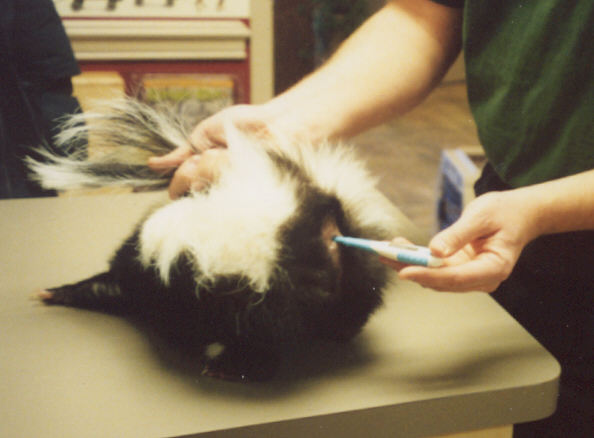 |
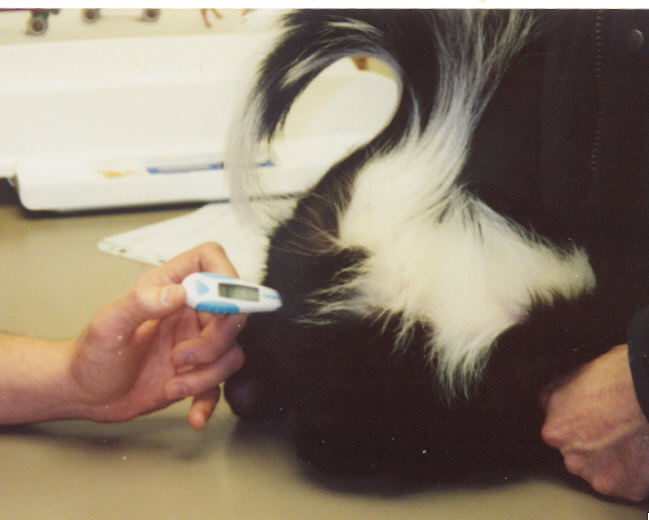 |
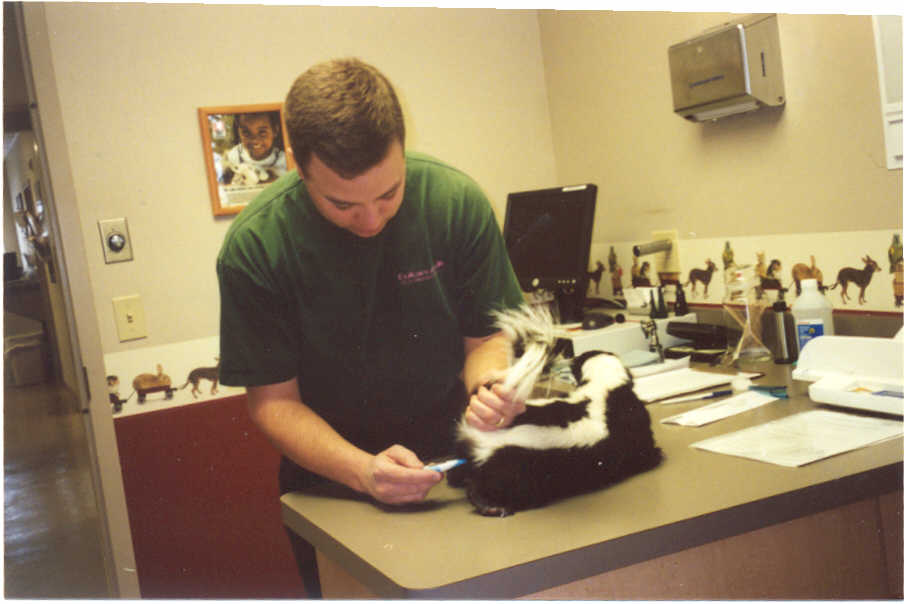 |
Lube the thermometer, slide the thermometer deep into the rectum, turn on and wait, once it beeps you will have a reading. |
Monitor your skunk(s) after meals to make sure they are not choking or have something stuck in their mouth. Skunks that eat fast, or will fight with other pets for foods, will get food or other things stuck in their mouth or throat. Some skunks will eat too much at a meal and throw-up some of the food, occasionally they will aspirate the food. Usually they will try to use their front nails to pull the object out, sometimes they are not successful and need your assistance.
If you have a skunk that is prone to choking, chop the food into fine pieces and make sure that you don't give anything thick, like peanut butter, without watering it down. You should soak dry (dog) food in water, or a 1:1 mixture of fruit juice and water, to soften the food. Sticky foods, like bread and moist grains, should be broken into small pieces and mixed well with other foods. Also make sure fresh water is available after meals.
If the skunk is still breathing (partial obstruction) try presenting sweetened water, juice, etc., to determine if the skunk will drink and possibly clear the object. Do not force the skunk to drink, you can try a few drops on the tongue or gums to induce the skunk to drink if necessary.
You should have a few plastic or wooden spoons, wooden sticks or pop-cycle sticks, or a rubber-coated baby spoon, that you can use to pry the skunk's mouth open and dislodge anything stuck in there. Be careful that you don't push the object farther into the throat! Do not put your fingers in the skunk's mouth!
If necessary you can use a modified Heimlich maneuver to help dislodge an object stuck in the throat:
If the skunk stops breathing you may have to perform CPR.
Chocolate contains theobromine, a compound that is
a cardiac stimulant and a diuretic. There is no antidote to Theobromide
poisoning. If less than two hours have passed since the ingestion, the first
step is to induce vomiting. This should get rid of 70% of the stomach's
contents. The vet may give the skunk repeated doses of activated charcoal to
move the poison through the system faster.
Medical treatment is supportive,
and may include all or some of the following:
Unsweetened (baker's) chocolate is the most dangerous. Semi-sweet chocolate and dark chocolate are the next most dangerous forms, with milk chocolate being the least dangerous.
If you witness your skunk eating chocolate or if it shows any signs of chocolate toxicity (anxiety, pacing, hyper-excitability, excessive thirst and urination, vomiting, or seizures): call your vet immediately and tell him or her what type of chocolate your skunk ate, how much you think it ate, how long ago he indulged itself, and how much your skunk weighs./p>
If more than a couple of hours have passed, the toxin will already be circulating in your skunk's system, so your vet will provide supportive therapy (such as intravenous fluids and drugs to
control hyper-excitability) while your skunk's body works to detoxify itself.
DOSING ACTIVATED CHARCOAL (remember to use
the charcoal in any case when an animal eats something toxic)
5ml-10ml per pound and
give 10ml-20ml per total weight every 6-8 hours for 24 hours. because skunks are
on the smaller side suggest use 5ml x's10ml for total weight. Example: For a 10
pound skunk--use 5ml per pound x's 10ml dose on
total weight= 50ml of charcoal. Any syringe has the (ml) doses on
it.
To order your Activated Charcoal product # 366-2 go here and Skunk Haven will get the credit ⇒ www.mynsp.com/skunkhaven
WARNING For Spring :
Cocoa Mulch, which is
sold by Home Depot, Foreman's Garden Supply and other Garden supply stores,
contains a lethal ingredient called "Theobromine". For more information call
Animal Poison Control (they will charge an initial fee for a consult)
1-800-548-2423; OR (American Society for the Prevention of Cruelty to Animals)
References:
www.avma.org,
www.petalia..com,
www.beaglesunlimited.com,
www.vetmedicine.about.com
Occasionally skunks will get cuts and other minor wounds. Do not assume a small scratch is nothing to worry about. Sometimes minor wounds become infected (especially bite wounds) and need vet treatment, often this can be avoided by proper cleansing and care of the wounds. Antiseptic liquids and ointments should be on-hand to treat bites and scratches. Get to a vet if there are signs of infection, redness, swelling, not healing, etc.
Occasionally a skunk will pull a nail, or a nail will split or crack and start bleeding, this usually produces profuse bleeding and requires immediate care. Styptic powder or flour can be used to stop the bleeding. Monitor the foot over the next few days to make sure it is not infected and it does not start bleeding again.
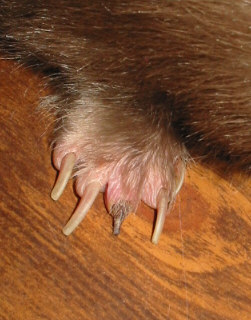 |
Use styptic powder or flour to stop bleeding. The nail will re-grow, within a few months there should be no sign of the nail being damaged. |
| Photo by Carol Infalt |
Topical cleaning with hydrogen peroxide generally is not done for more than a day as the peroxide breaks cells and slows the healing process, although it is a great cleaner at time of initial start of topical therapy. Peroxide should never be used internally, therefore flushing of wounds with peroxide is not recommended.
Overweight - Overweight skunks will have bone, internal organ, and general health problems. Monitor your skunk for excessive weight, rapid weight gain, laziness, etc.
Proper weight is based on the body length and bone structure of the skunk. Use your (and your vet's) best judgment when determining the best weight for your skunk.
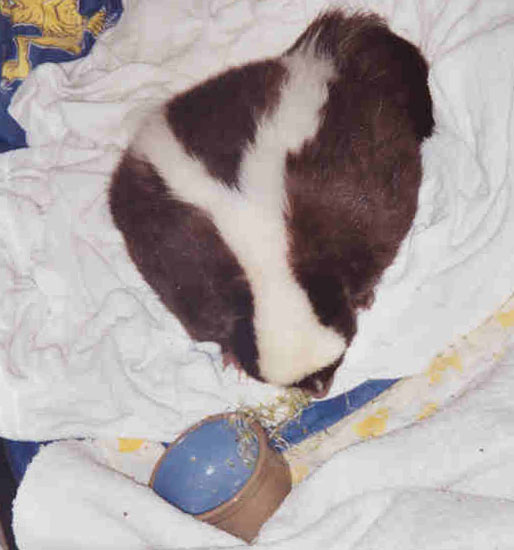 |
This skunk only weighs 10 lb, but she is
overweight and has damaged joints, bone loss, low muscle mass, and spends
most of her time sleeping. Even 1 lb over optimal
weight can lead to problems like this. This skunk is on joint conditioning treatment including glucosamine and colostrum, and calcium supplements to help strengthen her bones. She is given hydrotherapy and exercise sessions regularly to help strengthen her muscles. Her diet is limited to help her lose the excess weight. The bowl in this picture is about 3-1/2 inches (9 cm) in diameter. |
Although a skunk may gain or lose 25% (or more) of their optimal body weight over the course of a year, it is best to maintain a pet skunk's weight at or near their optimal. This reduces stress and improves the general health for the skunk.
Fasting (one of five meals) to reduce the weight may be recommended by your vet. Very small meals three or four times a day may be used to aid in weight reduction. In addition, significant exercise is recommended for your skunk, even in winter.
Underweight - Underweight skunks will suffer general mal-nutrition, suffer from seizures, etc. Monitor your skunk for excessive weight loss or other signs of mal-nutrition, worm your skunk regularly.
Malnourished skunks are more likely to have calcium and other mineral deficiency, vitamin deficiency, low blood sugar levels, and electrolyte imbalance. They will also suffer more from allergies, colds, infections, and other minor injuries due to their poor diet. Provide a balanced diet with sufficient amounts of calcium and other minerals, vitamins, protein, and carbohydrates.
Seizures - Many skunks have epilepsy, hypoglycemia (low blood sugar), electrolyte imbalance, allergies, or some other medical condition which may trigger seizures.
Administer corn syrup on side of mouth with spoon or syringe. Stop feeding fruit. Feed smaller meals 4 or 5 times per day.
Link to seizures in pets.
Parasites - Internal and external parasites can affect your skunks' health. Monitor you skunk for signs of parasites regularly and treat as necessary.
More information on parasites.
You can safely use Frontline (drops or spray) or Advantage (spray) for cats on your skunk. If using drops, give 1/2 the dosage prescribed for cats. Be careful of long term use of any chemical!
Worm your skunk! We have used Pro-Wormer-2 ® (Double Strength), and Panacur wormers for regular worming, these are available in pet supply or farm supply stores. You may also get Nemex-2 ®, and Droncet (injectable or oral) from your vet where prescribed for round-worm or tape-worm.
Additional information on common worming products.
We have found that garlic juice given in food will prevent flea and tick infestations, and helps prevent and eliminate roundworms. You can find garlic juice in the grocery store, put one or two drops on the food one meal per day.
© 2001-2015 Skunk Haven™ Skunk Rescue, Shelter, and Education, Inc.
Revised 03/20/14 (SRS)
 | ||
| Previous | SkunkHaven.Net Index | Next |
|
|